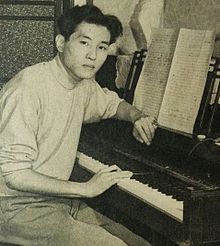Toshirō Mayuzumi
Toshirō Mayuzumi ( Japanese 黛 敏 郎 , Mayuzumi Toshirō ; born February 20, 1929 in Yokohama , Japan , † April 10, 1997 in Kawasaki , Japan) was a Japanese composer .
life and work
Mayuzumi, born in Yokohama in 1929, studied from 1945 to 1951 at the Tokyo National University of Fine Arts and Music with Tomojiro Ikenouchi (1906–1991) and Akira Ifukube (1914–2006). He graduated in 1951. Even as a student he described himself as an experimental and adventure-seeking composer. Sometimes he composed in the traditional style of the late romantics, sometimes he experimented with jazz rhythms and other times he tried his hand at implementing Indian and Balinese music. With the work Sphenogrammes in this idiom he gained an international reputation when it was performed at the ISCM Festival in 1951.
In the same year (1951) he went to Paris and completed his studies at the Conservatoire Superieur de Paris with Tony Aubin . In Paris he also familiarized himself with the new musical developments in the works of Olivier Messiaen and Pierre Boulez as well as with Musique concrète . 1953 returned to Tokyo, he founded together with Ikuma Dan and Yasushi Akutagawa the Sannin no Kai ( "the Three Group").
He was constantly experimenting with new ideas and techniques in his own works. His X, Y, Z was the first Japanese example of musique concréte in 1955 and his Shusaku I was also the first Japanese synthetic-electronic music in 1955. He also worked with prepared pianos, twelve-tone technique, serial and aleatoric methods. He also experimented with new creations and - in certain sound bodies - rather unusual instruments such as claviolin , electric guitar and other instruments and even with the instrumental compositions.
In 1958 he broke new musical territory with Nehan kokyokyoku - "Nirvana Symphony" . Obsessed with the sound of the Buddhist temple bells, he analyzed the sonorous tones acoustically and tried to reproduce them as far as possible in terms of sound quality, volume and the use of spatial impressions in his work. The result was winning the Otaka Prize in the annual composition competition in 1958.
He was u. a. also active in the electronic studio of the Japanese radio. In Japan he tried to spread new music with the group Ars Nova Japonica .
Works
Works for orchestra
- 1950 Symphonic Mood
- 1951 Sphenogrammes
- 1953 Bacchanale - Kyoen
- 1956 Pieces for Prepared Piano and Strings
- Prologue
- Interlude
- final
- 1958 Nehan kokyokyoku - "Nirvana Symphony" Buddhist cantata for male choir and large orchestra
- Campanology I
- Suramgamah
- Campanology II
- Mahaprajnaparamita
- Campanology III
- final
- 1959–1960 Mandala Symphony
- Mandala Vajra-dhatu (The Diamond World)
- Mandala Garbha-dhatu (The Matrix World)
- Concertino for Xylophone and Orchestra
- 1962 Bugaku (Court Dance Music) (Ballet) for Orchestra
- 1963 Essay for string orchestra
- 1964 Olympic Campanology
- 1971 Symphonic Poem "Tateyama"
- 1984 The Kabuki for Orchestra, Joruri (narrative) Shamisen, Sangen and Shakuhachi
- 1989 perpetual motion machine
- 1991 The World Prayers for orchestra and tape
- 1992 Rhapsody for the 21st Century
- Geka (Pratidesana) Buddhist cantata
- Ectoplasm
- Samsara symphonic poem
Works for wind orchestra
- 1966 Concerto for Percussion and Wind Orchestra
- Concerto for Trampoline and Wind Orchestra
- Fireworks
- Music with sculpture
- Noah's Ark from the movie "THE BIBLE"
- Texture
- The Ritual Overture for Wind Orchestra
- Theme from film "THE BIBLE"
- Tone Pleromas 55
Choral music
- Sange for male choir
Stage works
- 1976 Kinkakuji (The Temple Fire) Opera - Berlin
- 1996 Kojiki Oper - Linz, Austria
Chamber music
- 1946 violin sonata
- 1948 Divertimento for ten instruments
- 1961 Metamusic for Piano, Violin, Saxophone and Conductor
- 1961 Prelude for String Quartet
- 1989 Rokudan for harp
- Bunraku for violoncello solo
Piano music
- 1966 Campanology by multipiano
- Hors d'oeuvre for piano
- Dance of Golden Branch from "Kaguyahime"
Electronic music
- 1953 X, Y, Z
- 1954 Music for Sine Wave by Proportion of Prime Number
- 1954 Music for Modulated Wave by Proportion of Prime Number
- 1954 Invention for Square Wave and Saw-tooth Wave
- 1955 Shusaku I
- 1956 Variations on numerical principle of 7
- 1969 MANDARA with source of Voice and Electric sound
- Akasen-chitai "Red District" Music for a film
Film music
- 1956 Masako - Onna no issho
- 1956 Street of Shame - Akasen chitai
- 1958 Temple to the Golden Hall
- 1959 Christ in bronze - Seido no Kirisuto
- 1959 Good morning - Ohayo
- 1959 Ginza girls - Onna ga kaidau o agarutoki
- 1959 A murderer's strategy - Yaju shisubeshi
- 1960 pigs, geishas and sailors
- 1961 Autumn of the Kohayagawa family - Kohayagawa-ke no aki
- 1963 Bushido - Love them and kill them
- 1963–1964 Forbidden Passion - Akai satsui
- 1964 The insect woman - Nippon konchuki
- 1964 love of the girl Kiyono - Shuen
- 1964 Tokyo Olympic 1964
- 1965 The Bible
- 1966 reflection in the golden eye
- 1966 Jinruigaku nyumon
- 1968 Mr. Kugelblitz strikes
- 1969 letter to the Kremlin
- 1970 Surf - Shiosai
- 1993 Dance on the Abyss
- 1995 The Convent
Japanese traditional music
- 1958 A hun for three no instruments
- 1970 Showa Tenpyo-raku
Web links
- Literature by and about Toshirō Mayuzumi in the catalog of the German National Library
- Toshirō Mayuzumi in the Internet Movie Database (English)
Individual evidence
| personal data | |
|---|---|
| SURNAME | Mayuzumi, Toshirō |
| ALTERNATIVE NAMES | 黛 敏 郎 (Japanese) |
| BRIEF DESCRIPTION | Japanese composer |
| DATE OF BIRTH | February 20, 1929 |
| PLACE OF BIRTH | Yokohama , Japan |
| DATE OF DEATH | April 10, 1997 |
| Place of death | Kawasaki , Japan |
